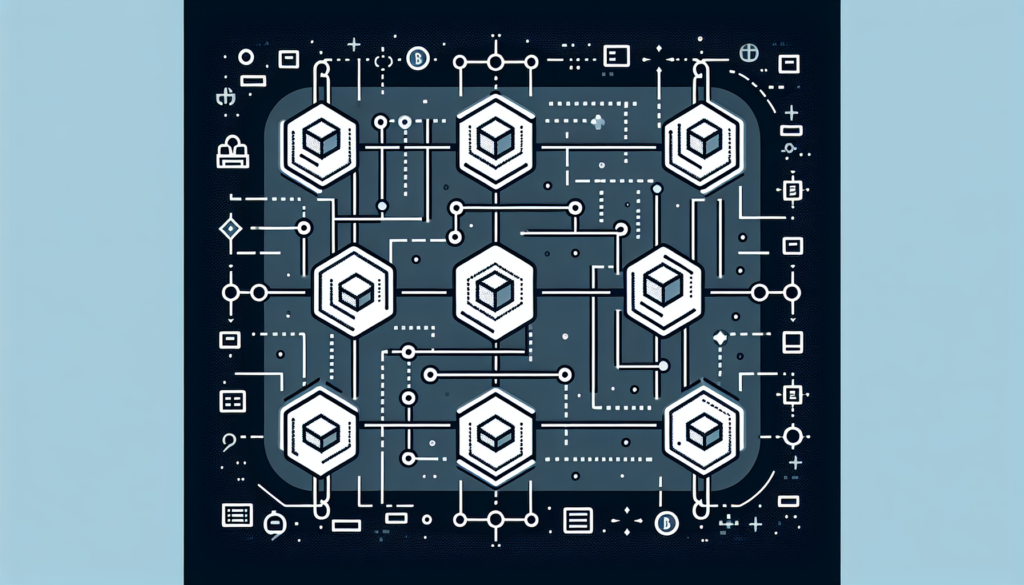You’ve probably heard the buzz around blockchain, but do you really know what it is? In simple terms, blockchain is a decentralized digital ledger that records transactions across multiple computers. It allows for transparent and secure record-keeping without the need for a central authority. Imagine a shared database where information is continually updated and validated by a network of participants. This article aims to demystify blockchain, break down its fundamental concepts, and explore its real-world applications that go beyond cryptocurrencies. So, let’s embark on a journey to understand the power of blockchain technology and its potential to revolutionize various industries.
What is blockchain?
Definition of blockchain
Blockchain is a decentralized and distributed digital ledger that records transactions across multiple computers or nodes. It is a technology that enables the secure and transparent storage and transfer of information without the need for intermediaries. In simple terms, blockchain is like a digital version of a traditional ledger, but with enhanced security and transparency.
How does blockchain work?
Blockchain works by creating a chain of blocks, where each block contains a list of transactions. These transactions are verified by network participants, known as nodes, through a consensus mechanism. Once the transactions are verified, they are added to a block, which is then added to the blockchain. This process ensures that each transaction is recorded and cannot be altered or removed, making the blockchain highly secure and tamper-proof.
Key components of blockchain
The key components of blockchain include:
-
Decentralization: Unlike traditional centralized systems, blockchain operates on a decentralized network of nodes, eliminating the need for a central authority.
-
Distributed ledger: The ledger that records transactions is distributed across multiple computers or nodes, ensuring transparency and eliminating the risk of a single point of failure.
-
Consensus mechanism: Blockchain uses a consensus mechanism, such as proof of work or proof of stake, to validate and verify transactions before they are added to the blockchain.
-
Cryptography: Blockchain utilizes cryptographic algorithms to secure and protect the data stored on the blockchain, ensuring that transactions and information remain confidential and tamper-proof.
Benefits of blockchain
Transparency and immutability
One of the key benefits of blockchain is its transparency and immutability. Since the ledger is distributed across multiple computers, all participants in the network have access to the same information. This transparency ensures that all transactions can be audited and verified, reducing the risk of fraud and corruption. Additionally, once a transaction is recorded on the blockchain, it cannot be altered or deleted, ensuring the integrity and immutability of the data.
Enhanced security
Blockchain offers enhanced security compared to traditional systems. By utilizing cryptographic algorithms, blockchain ensures that transactions and data stored on the blockchain are secure and tamper-proof. The decentralized nature of blockchain also reduces the risk of a single point of failure and makes it difficult for hackers to compromise the network.
Improved efficiency
Blockchain has the potential to improve efficiency in various industries. By removing the need for intermediaries and automating processes, blockchain can streamline transactions and reduce delays and paperwork. This can lead to faster and more efficient processes, saving time and resources for businesses.
Cost savings
Blockchain technology can also result in cost savings for organizations. By eliminating the need for intermediaries and reducing manual processes, blockchain reduces transaction costs. It also minimizes the risk of fraud and reduces the need for audits, resulting in further cost savings.
Decentralization
Decentralization is a fundamental aspect of blockchain technology. By removing the need for a central authority, blockchain allows for peer-to-peer transactions and empowers individuals to have more control over their data and transactions. This decentralization can lead to increased trust and empower individuals in various industries.

Applications of blockchain
Cryptocurrencies
Cryptocurrencies, such as Bitcoin and Ethereum, are one of the most well-known applications of blockchain technology. Blockchain enables secure and transparent transactions of digital currencies, removing the need for intermediaries, such as banks.
Supply chain management
Blockchain has the potential to revolutionize supply chain management by providing a transparent and traceable record of every transaction and movement of goods. By using blockchain, companies can ensure the authenticity and provenance of their products, reduce fraud, and improve efficiency in the supply chain.
Smart contracts
Smart contracts are self-executing contracts with the terms of the agreement written directly into code, stored and executed on a blockchain. They automatically execute the terms of the agreement, reducing the need for intermediaries and ensuring transparency and efficiency in contract management.
Voting systems
Blockchain can be used to create secure and transparent voting systems. By recording votes on a blockchain, the integrity of the voting process can be ensured, and the risk of tampering or fraud can be minimized. This can lead to increased trust in the voting system and more accurate results.
Healthcare records
Blockchain has the potential to transform the healthcare industry by securely storing and sharing patient records. By using blockchain, patients can have more control over their medical data, while healthcare providers can ensure the integrity and privacy of sensitive patient information.
Intellectual property protection
Blockchain can be used to protect intellectual property rights by providing a tamper-proof record of ownership and copyright. Artists, musicians, and other creators can use blockchain to register their work and prove its authenticity and ownership.
Challenges and limitations of blockchain
Scalability
Scalability is one of the major challenges facing blockchain technology. As the number of transactions and users on the blockchain increases, the network can become congested and slow down. Scalability solutions, such as sharding and layer 2 solutions, are being developed to overcome this challenge.
Energy consumption
Blockchain technology, especially proof of work consensus mechanisms, requires a significant amount of computational power and energy consumption. This has raised concerns about the environmental impact of blockchain and the sustainability of its energy consumption.
Regulatory concerns
The regulatory landscape surrounding blockchain is still evolving, with many jurisdictions struggling to keep up with the pace of technological advancements. Unclear regulations and legal frameworks can create barriers to adoption and hinder the development of blockchain applications.
Lack of standardization
The lack of standardization in blockchain technology can hinder interoperability and collaboration between different blockchain networks. This lack of standardization makes it difficult to develop scalable and widely adoptable blockchain solutions.
Education and awareness
Despite the growing interest in blockchain technology, there is still a lack of education and awareness among the general public and businesses. This lack of understanding can create barriers to adoption and hinder the widespread use of blockchain in various industries.

Blockchain vs. traditional databases
Data storage and access
Traditional databases store data in a centralized manner, making it susceptible to data breaches and unauthorized access. In contrast, blockchain distributes data across multiple nodes, making it more secure and resistant to hacking.
Data integrity and security
Blockchain ensures the integrity and security of data through its immutability and cryptographic algorithms. Traditional databases may be vulnerable to data manipulation and tampering.
Data ownership and control
In traditional databases, data ownership and control usually reside with the centralized authority. With blockchain, individuals can have more control over their data and decide who can access and use it.
Consensus mechanisms
Traditional databases rely on a central authority to validate and verify transactions. Blockchain, on the other hand, utilizes consensus mechanisms that involve multiple participants in the validation process, ensuring the accuracy and integrity of transactions.
Blockchain use cases
Financial services
Blockchain has the potential to disrupt the financial services industry by offering faster and more secure transactions, reducing costs, and enabling new financial products and services.
Real estate
Blockchain can revolutionize the real estate industry by providing transparent and secure title transfers, reducing fraud, and streamlining the buying and selling process.
Logistics and supply chain
Blockchain can improve efficiency and transparency in logistics and supply chain management by providing a reliable record of every transaction and movement of goods.
Healthcare
Blockchain can transform healthcare by securely storing and sharing patient records, improving interoperability between healthcare providers, and enhancing data privacy and security.
Public sector
Blockchain can be used in the public sector to improve transparency, traceability, and efficiency in government processes, such as identity management, voting systems, and public procurement.
Education
Blockchain technology has the potential to revolutionize the education industry by providing a secure and portable record of academic achievements, enhancing the verification process, and reducing fraud.

Blockchain adoption and future trends
Current state of blockchain adoption
Blockchain adoption is still in its early stages, with various industries and organizations exploring its potential applications. While some industries, such as financial services and supply chain management, have made significant progress in adopting blockchain, others are still in the early stages of exploration and experimentation.
Potential barriers to adoption
Despite the potential benefits of blockchain, there are several barriers to adoption that need to be addressed. These include regulatory uncertainty, scalability challenges, lack of standardization, and the need for education and awareness.
Emerging trends and developments
The future of blockchain technology looks promising, as new trends and developments continue to emerge. These include the integration of blockchain with other technologies, such as artificial intelligence and the Internet of Things, the rise of blockchain interoperability solutions, and the development of more sustainable consensus mechanisms.
In conclusion, blockchain is a transformative technology that has the potential to revolutionize various industries. Its benefits, such as transparency, enhanced security, improved efficiency, cost savings, and decentralization, make it attractive for a wide range of applications. However, challenges and limitations, such as scalability, energy consumption, regulatory concerns, lack of standardization, and education and awareness, need to be addressed for blockchain to reach its full potential. Despite these challenges, blockchain adoption is growing, and the future holds exciting possibilities for this innovative technology.
